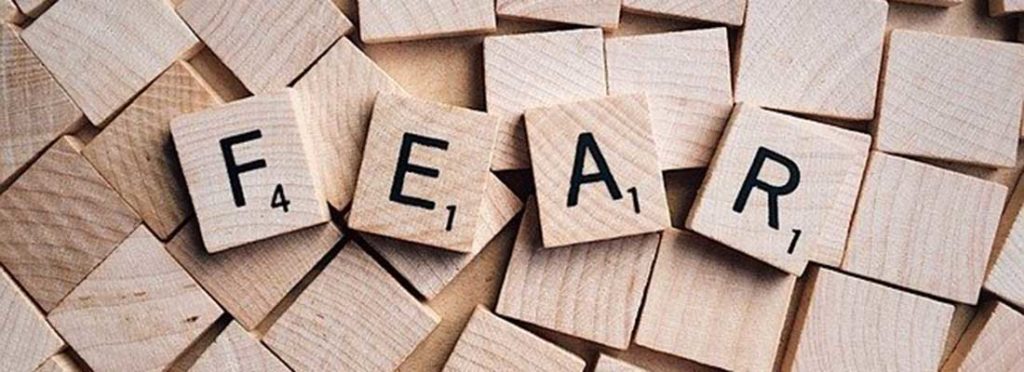Most people think of the acronym for FEAR being “False Evidence Appearing Real”. The consequences of thinking this way keeps you stuck and unable to move forward. As a result, you focus and feed your imagination on the negatives. Consequently, feelings of anxiety, overwhelm, and paralysis are generated.
For example, take the info-pandemic that has emerged with COVID-19. A lot of false evidence appearing real has triggered FEAR on a global scale. The panic reactions has caused a run on toilet paper, hand sanitizer, and face masks. The financial markets have plummeted. And governments are closing borders and requiring people to go into self-isolation for weeks.
Has Our FEAR Spiralled Out of Control?
It would be nice to be able to time travel. Because I’m sure, looking back to now, this will be a teachable moment about the popular acronym for FEAR “False Evidence Appearing Real” getting out of control.
Over the past years, I have learned how vital it is to not jump to conclusions to quickly. Most importantly, in situations where events are unfolding in real-time, via the Internet. Because it’s too easy to get sucked into the FEAR vortex.
Consequently, we must remember it takes time for the facts to come in. For instance, the medical and science professionals are analysing what is happening and publishing their findings without taking time to peer review.
Popular Acronym for FEAR Goes Viral
Unfortunately, in present time, theories are being shared as soon as they pop into someone’s head. As a result, anyone with a keyboard and Internet connection now considers themselves as an “expert” on the event. Even if they are thousands of miles away from where the event is happening. Especially if they got their information from content shared virally.
♦ “This information is on [insert social media platform], therefore it must be true.”
♦ “I read it on [insert news media site] so the journalist will have done the fact-checking.”
♦ “Because this person states they heard it from an unnamed medical professional at a dinner party.”
♦ “An unidentified “expert” from (insert location that could loosely be connected with an academic institution) says…”
Note: in the last example, I am referring to this confirmed “Stanford tips” hoax circulating via email and social media.
Update: I received some lovely feedback from a reader, Sara. She pointed me to this very helpful guide by Sharon Hurley Hall from Website Planet, which provides in-depth information on fake news, and especially in relation to Covid-19. There are a lot of great tips on there to help you identify and report fake news, etc.
How I Identify Misinformation, Hoax Tips, and Fake News
Whenever someone shares something with me on social media, I do a fact check. I may not get it right all the time. But most of the times I quickly identify if it is fact or fiction. The clues I look for are:
♦ Is the source identified by name?
♦ Do they have qualifications relevant to the topic they are talking about?
♦ Is there a link to their website included in the post?
♦ In situations like the “Stanford tips”, there was no actual mention of Stanford University, just an allusion.
♦ Finally, I also do a Google search entering a key phrase from the content.
More often than not, I discover that this is indeed a hoax. So instead of sharing it, I try to stamp it out. In other words, I advise the person who shared it with me that it’s fake. Now, I may end up losing friends, and I’m okay with that.
Misinformation, fake news, and hoaxes seem to spread faster than the most viral disease. Therefore it’s time for humans to stop letting fake news and social media posts trigger our fears. Step back from the emotion and don’t get fixated on the negative. Furthermore, it’s not healthy to let anxiety and overwhelm run our lives.
Reframe the Acronym for FEAR to “Factual Evidence: Analyse, Respond”
Most importantly, we need to urgently reframe the acronym for FEAR. Consequently, the method I outline above is “Factual Evidence: Analyse, Respond”.
Firstly, use self-isolation downtime to develop your critical thinking and deep-dive research skills. Start with identifying who the real experts are. Then start to trust what they are saying. Or if you are unable to do that – then do this. Put down your devices. Turn off the news. Stop logging into social media 24/7/365. Then establish what you steps you need to take to protect yourself. Next create an action plan. Focus on building your immunity up. And set up an emergency kit of non-perishable items and treats to keep you going for at least 14 days. Think about ingredients to make tasty meals from. Buy canned and frozen foods. And don’t forget to get in enough supplies for your pets too.
How to Use Your Downtime to Invest in Your Future
In conclusion, history has proven that this, too, shall pass. Most of the FEAR being created is through False Evidence Appearing Real. Instead, reframe the acronym for FEAR into “Factual Evidence: Analyse, Respond.“
If you need help with this, as well as disaster proofing your life, join me inside KESWiN™ Academy. I’m leading people through a 13 week self-discovery quest. Firstly, we focus on changing the things that don’t work in your life. Then, we look within to discover your unexpressed passion. Next, we set goals, and create an action plan to achieve a well-formed outcome.
To learn more or join me on this quest, contact me here.
Start empowering others by sharing this article
Other Articles

Is Passion Helping or Hindering You?
Passion is a strong or extravagant fondness, enthusiasm or desire for your area of expertise. Definition from Dictionary.com One of the life’s best kept secret is passion. Being passionate drives

Entrepreneurship Quiz: Are You 100% Happy?
This entrepreneurship quiz helps you to take 100% ownership for the path you travel. You will self-assess your happiness with 10 key areas in your life, and see how much

Personal Development Quest: Introduction
A personal development quest focuses on transforming some aspect of your life in a significant way. Alternatively, you may be changing something in your external world that affects you. In

